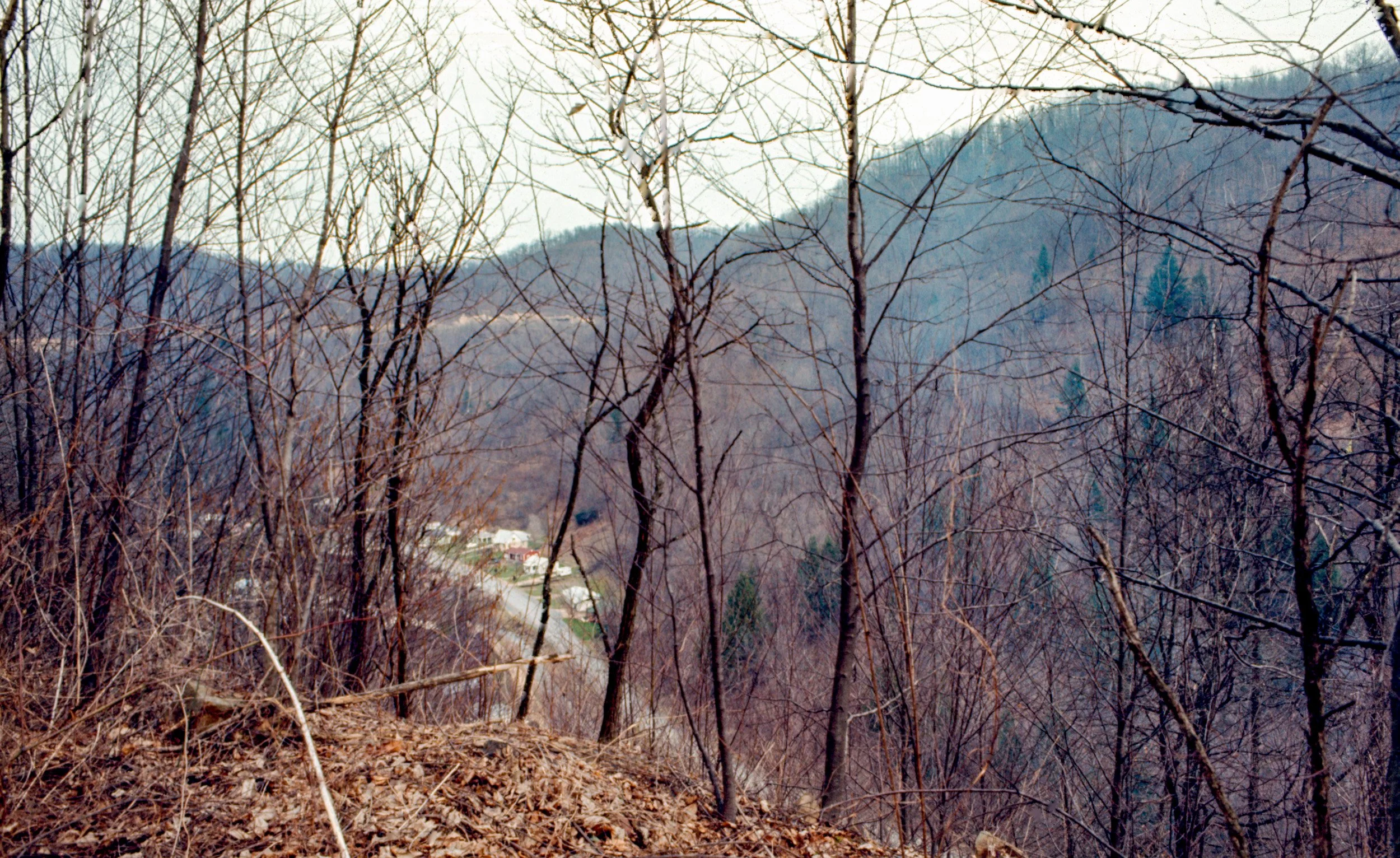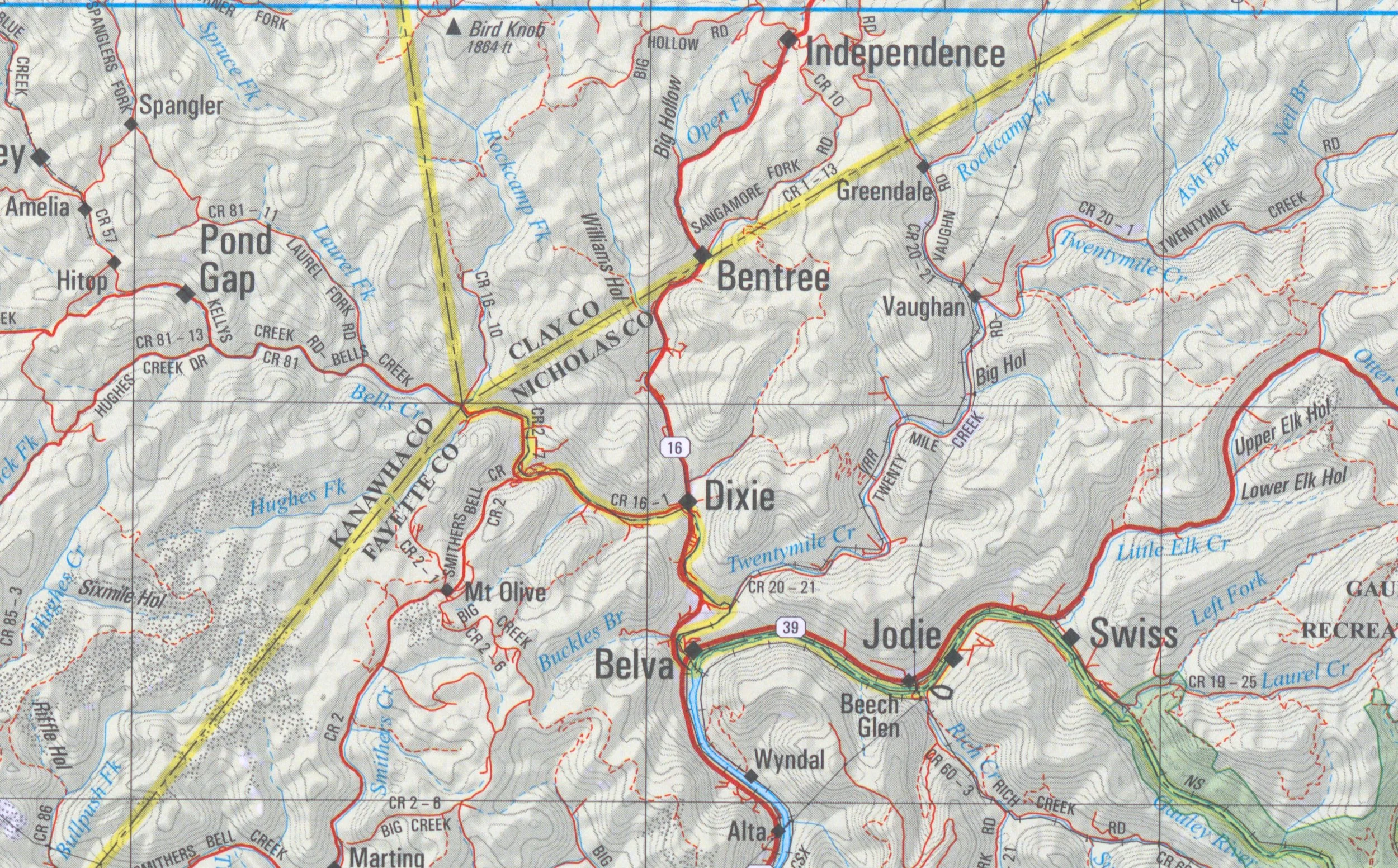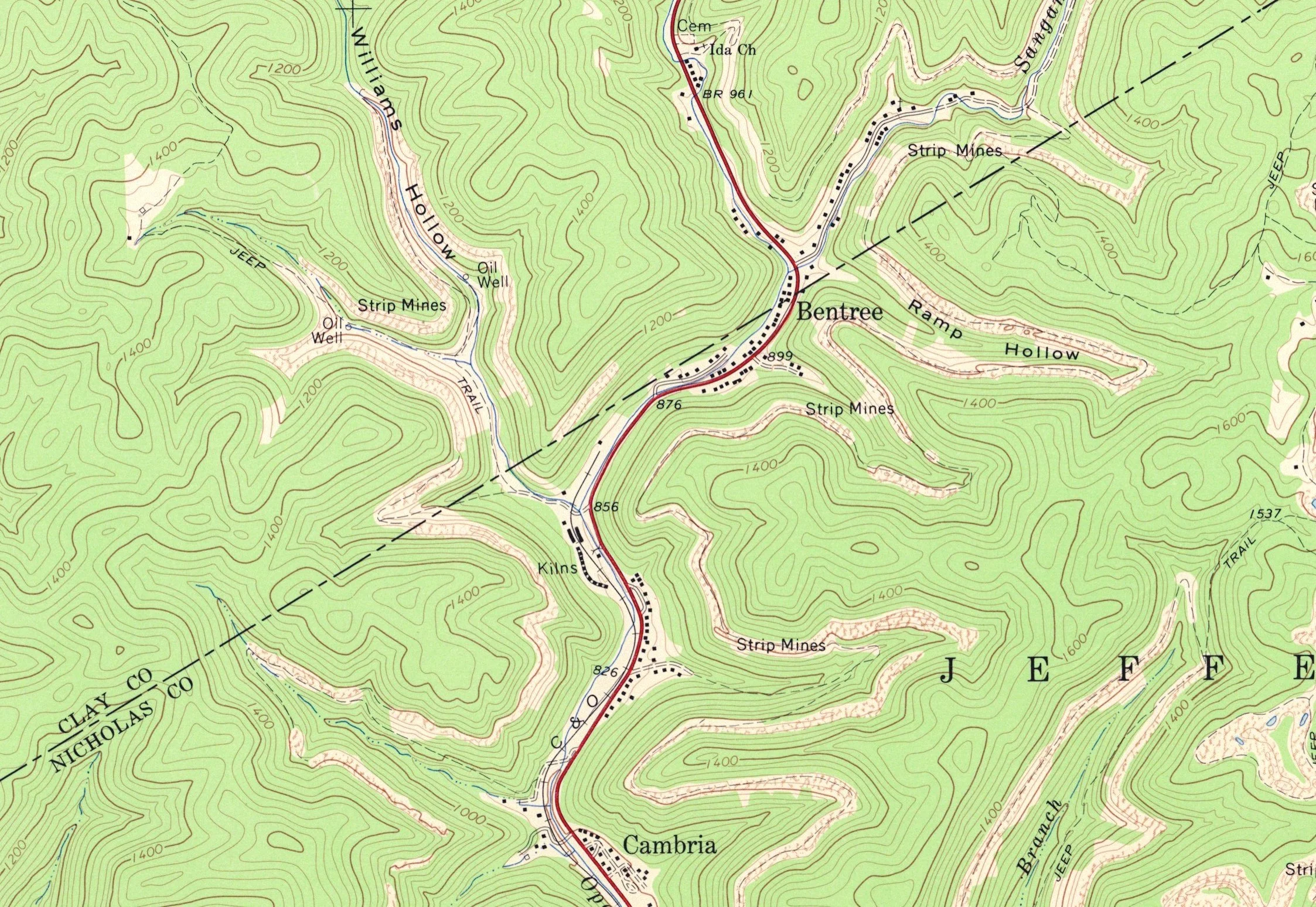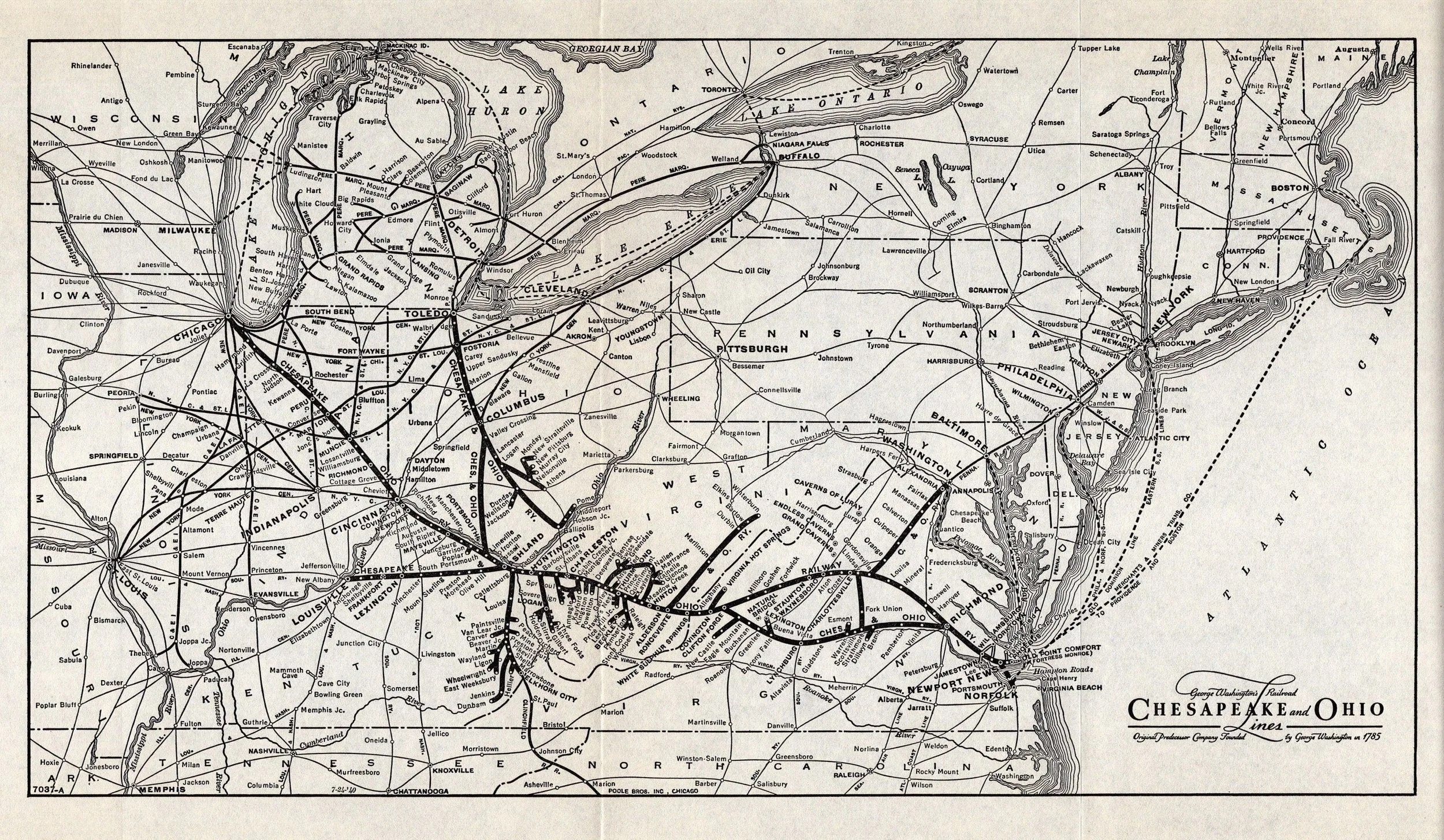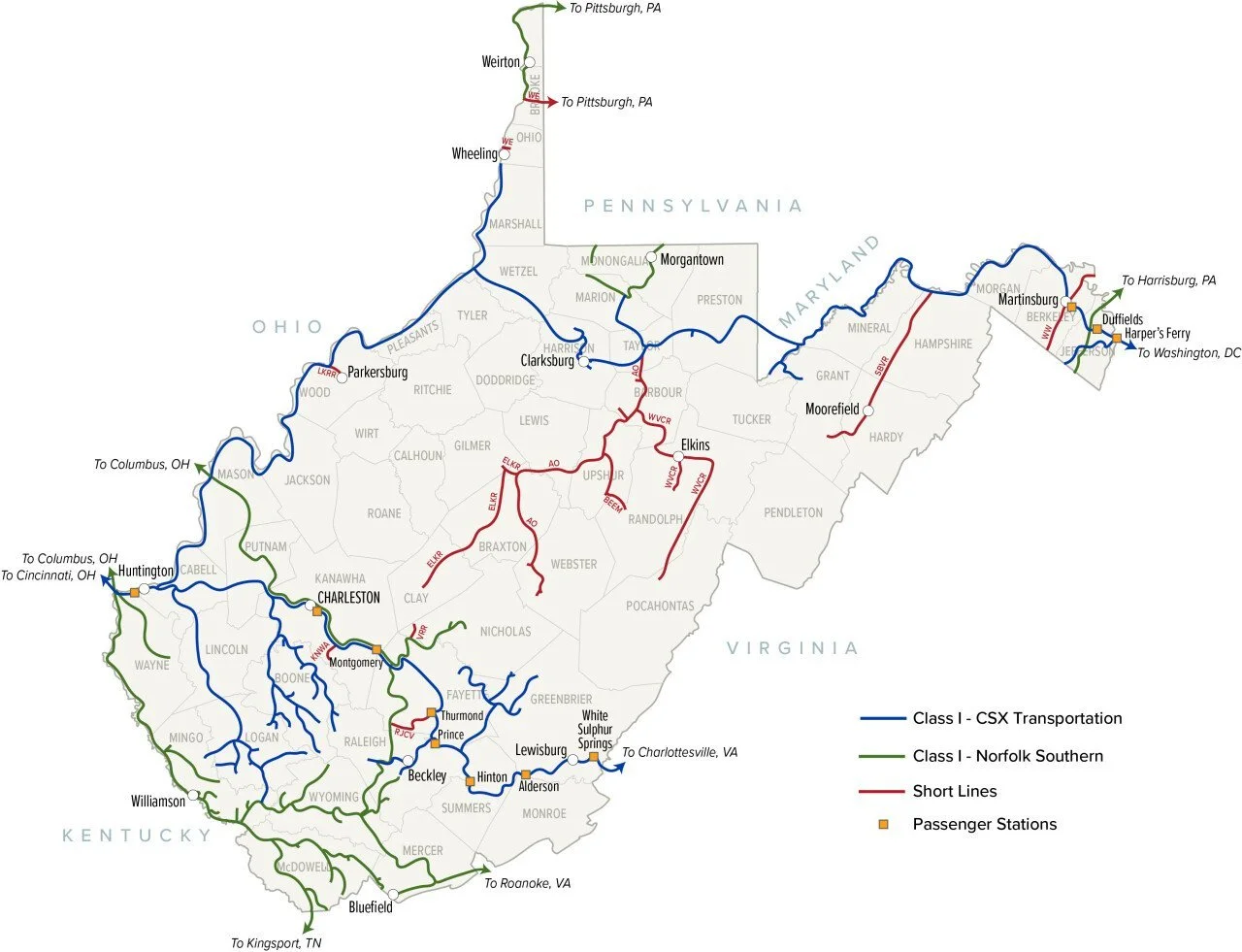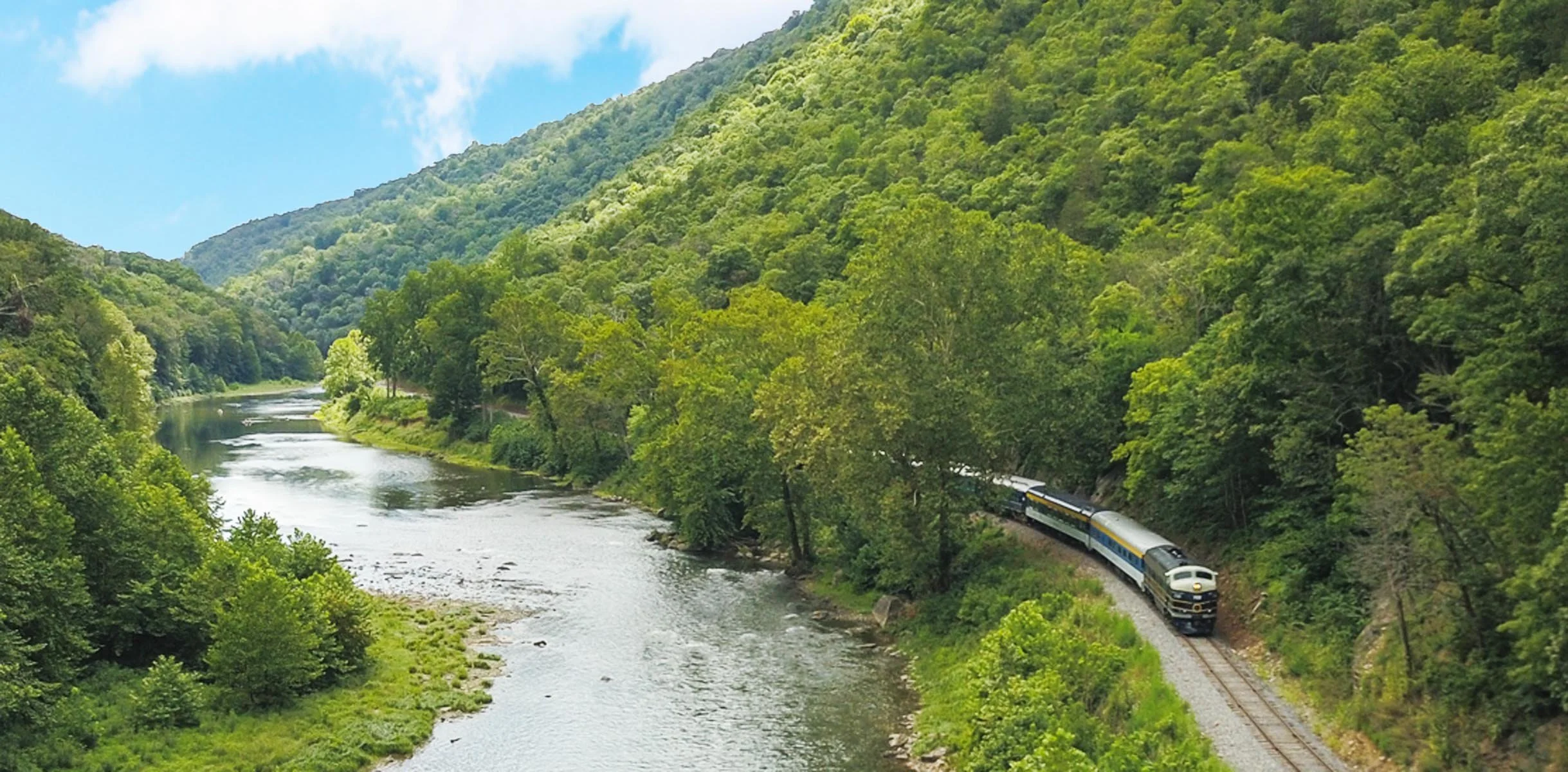Bentree General Information
Introduction:
Since BentreeConnections is the website name, I thought it would be beneficial to review a little of the history of Bentree itself. Both sides of my family lived there, as did I for the first twenty-one years of my life. Although some would say it is in the “boonies”, I always thought it was a great place in which to grow up. I have enduring memories of exploring the mountains, walking the railroad track, catching minnows in the creek, playing baseball with friends, working on cars, and a host of other activities.
[The photo below was taken April, 1972, from the mountainside across from our house. You can see the peach-colored stucco house between the trees, next to the red house.]
As a family history website, I will be focusing on the Bentree of the past (starting about 150 years ago). What is happening today is of secondary interest. The community has changed significantly over the years. (Uncle Damon mentions this in one of his stories.) I don’t know much about the community in the 21st century. One person told me that I would probably not know more than two or three people living there now. I drove through Bentree a few years ago—I hardly recognized anything.
So, this module about Bentree will focus primarily on the past, rather than the present or future.
Table of Contents:
• Introduction
• Geography of the Area
• George Henry Rider was the First Settler
• Rich in Natural Resources
• Logging was the First Industry
• Coal was King!
• The Railroads Enabled it All
• What’s in a Name?
• The Post Office Legacy
• Bentree Families Remembered
Geography of the Area:
Bentree is located on WV State Route 16, in both Clay and Nicholas Counties. A few maps are included here, for reference.
This is rugged terrain. The bottom land is narrow (only a few hundred yards at its widest). There is just enough room for the creek, the road, and a row or three of houses. The tree-covered mountains on both sides are a little less than 1,000’ (from valley to top), but they are typically steep.
————————————————————————-
Image 1: This is a wide-view of Bentree and surrounding communities.
Image 2: This is a shaded, relief map (about the same area as Image 1). It shows the mountains substantially better.
Image 3: This is a close-up topographical map of Bentree from the 1967 USGS “Bentree Quadrangle.” You can see the individual houses!
George Henry Rider
George Henry Rider was Probably the First Settler:
In the 1870’s, the Scotford/Bentree area was not quite a wilderness, but it was devoid of population. There was a wagon trail (later to become SR16) between Gauley Bridge and Lizemores…but there was little else. George Henry Rider (who is my great, great grandfather) settled there sometime between 1875 and 1879—before it had a name.
My grandmother, Laura Rider Kiser, said that GHR owned hundreds of acres of land, encompassing all of what would become Scotford/Bentree—including the area where I grew up. He was probably the pioneer settler and instrumental in developing the area.
Rich in Natural Resources:
Ample fresh water, dense hardwood forests, fertile bottomland, and plentiful wildlife for food would have enticed people to explore the area. Although farmland is somewhat limited, Bentree has always had abundant natural resources: timber, coal, oil, and natural gas.
Take another look at the USGS topo map. You will see oil wells in Williams Hollow (which we always called Gauley Hollow) and strip mines all around Bentree. Not shown on this map is a natural gas well just about where the 876’ elevation marker is located.
It was around 1900 that the remote valley was engulfed by industrialization. The logging and coal & oil booms brought population and prosperity to the area. All of this was enabled by the propagation of railroads (see comments below).
Logging was the First Industry:
Logging (and associated sawmills) was the first industry in Bentree. Granny said there were about seven different operations when she was a youth. All of these would have been local outfits. [A few decades later, Great Grandpa Albert Mullins would bring his sawmills to Bentree.]
This was still in the era of first-growth timber, so the trees were huge (up to 18’ in diameter!). All of these logging photographs below were taken around 1900, in West Virginia.
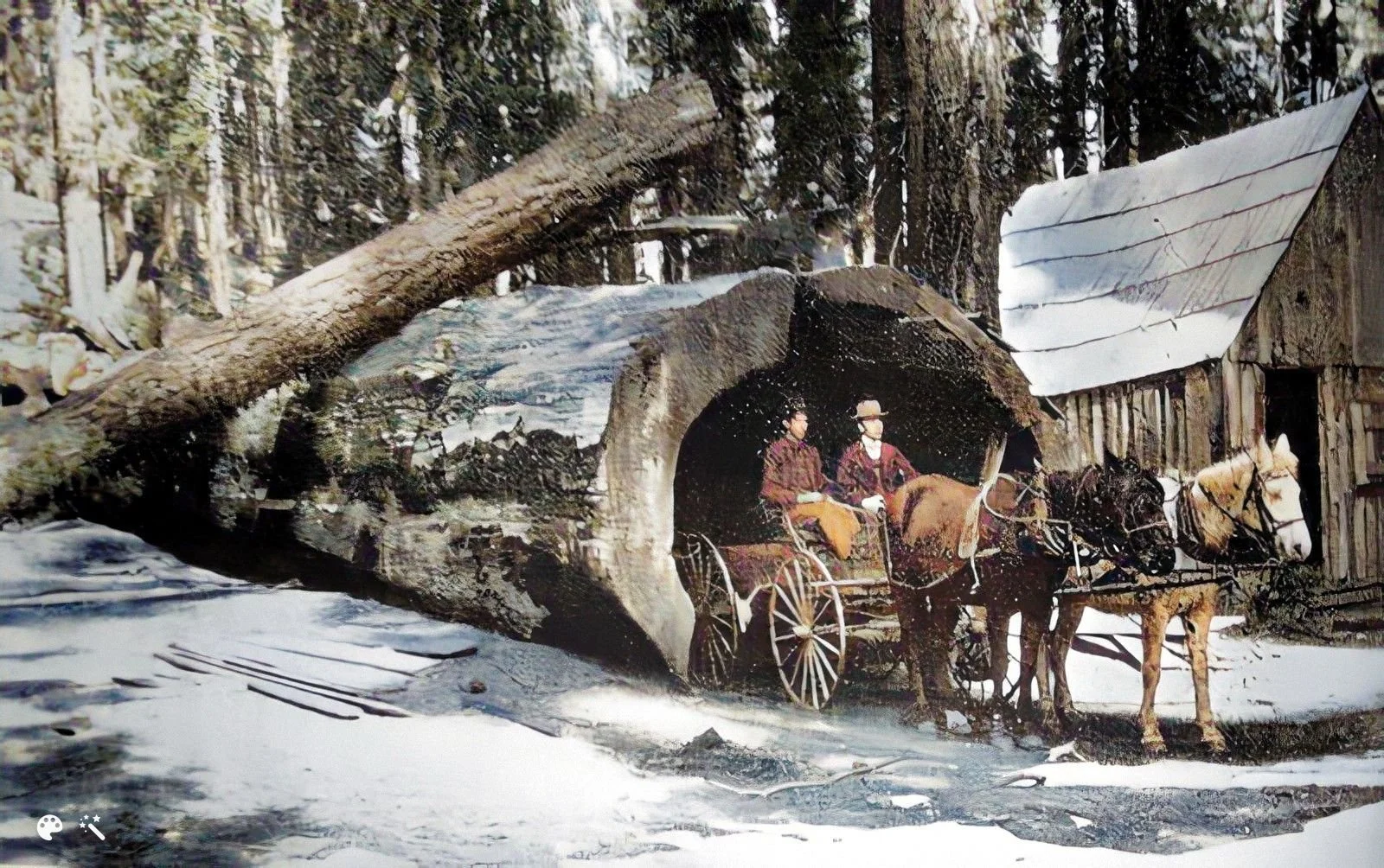
Abt 1900, Southern WV

Abt 1900, Southern WV (largest tree recorded)
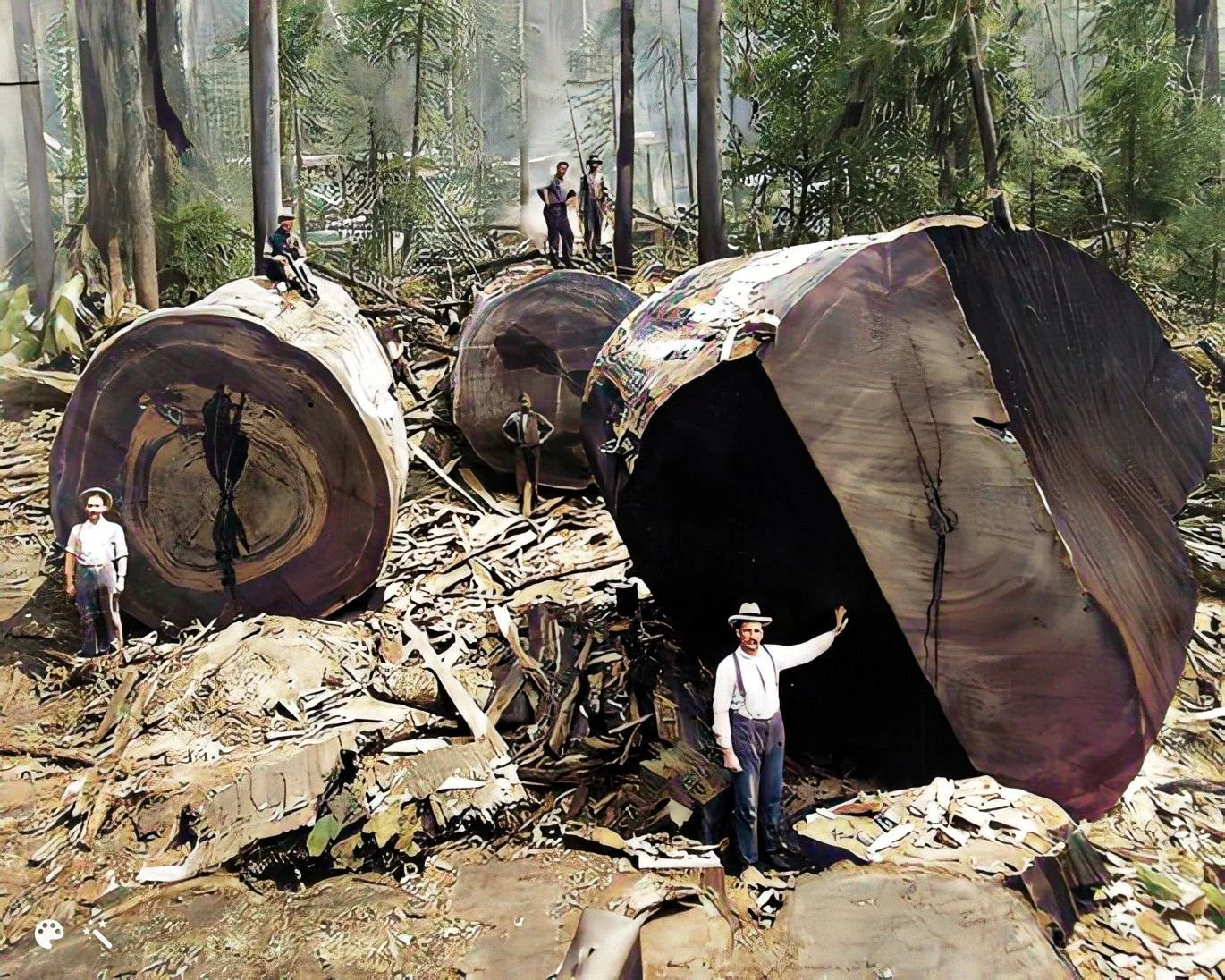
Abt 1900, Fayette County, WV
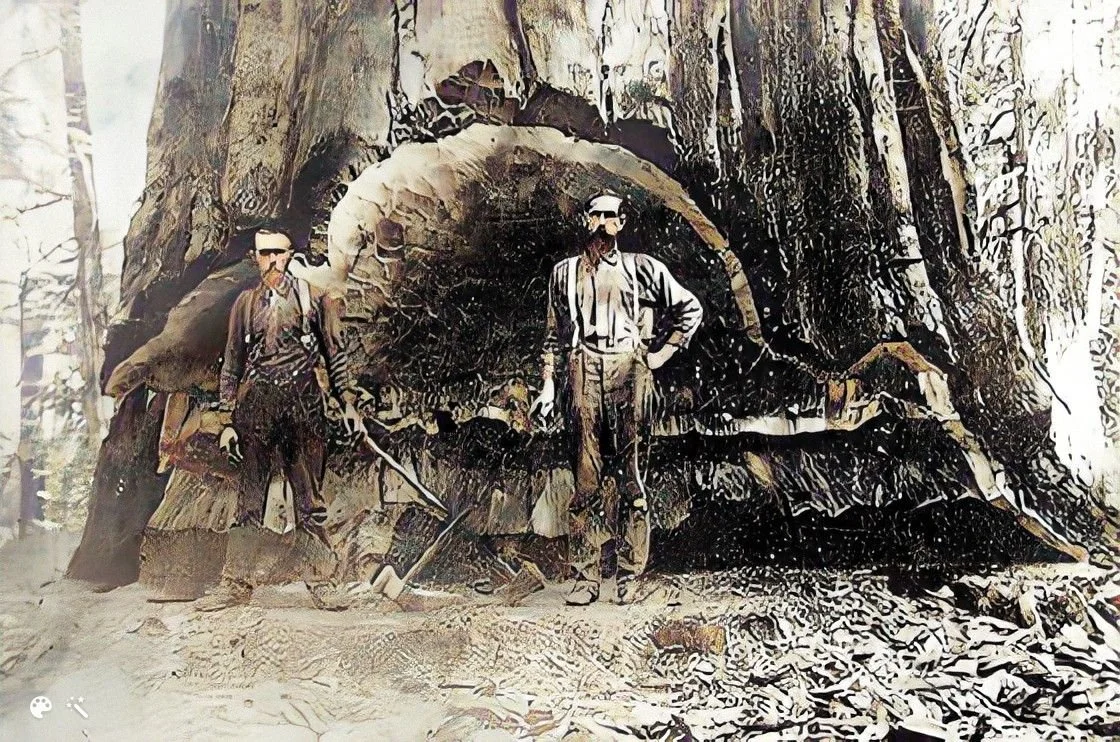
Abt 1900, Southern WV
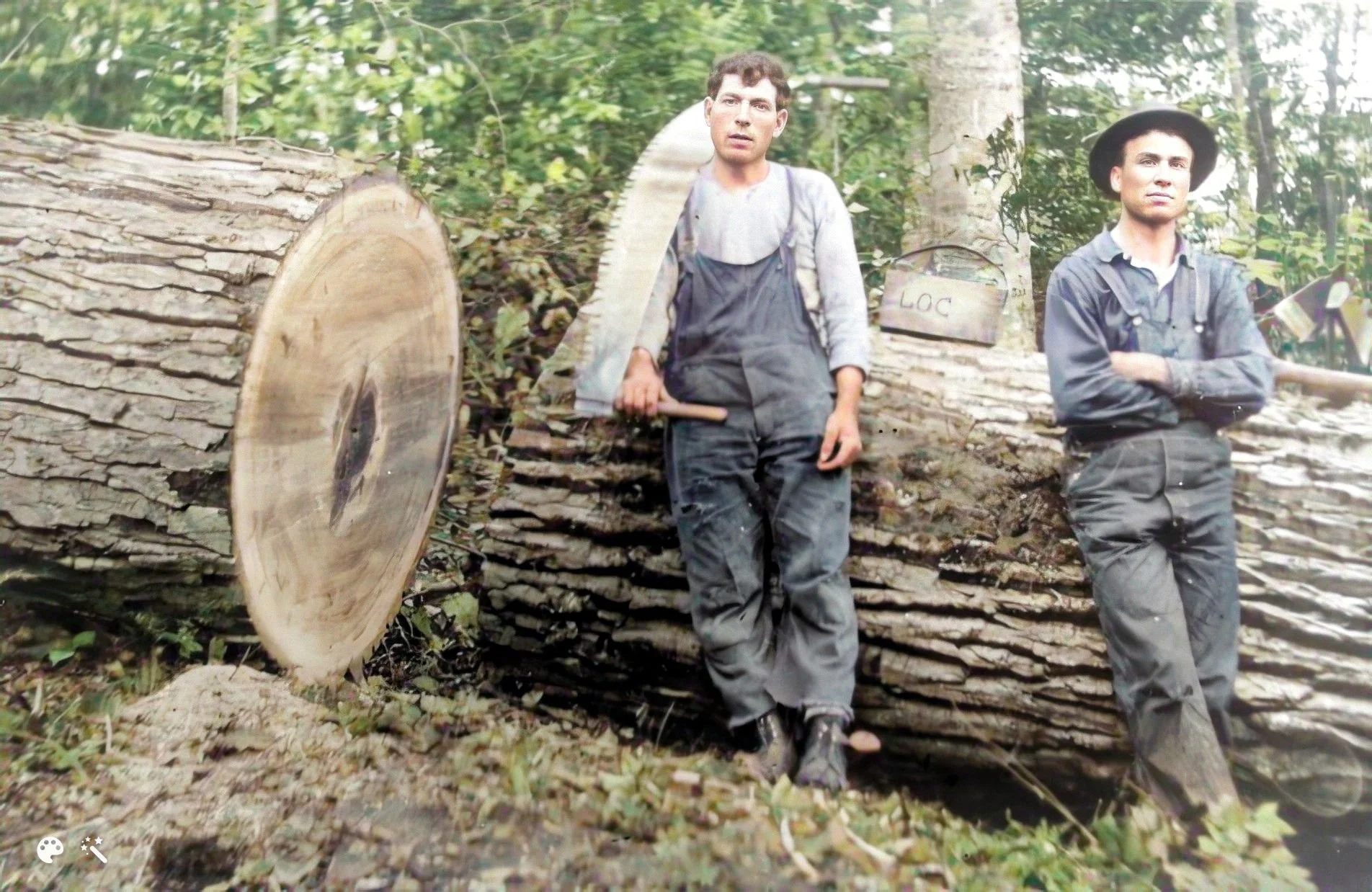
1894 Canaan Valley, WV
Remnants of Virgin Timber:
I can envision the land that greeted GHR…one covered with trees that reached over 200’ height. Unfortunately, the greedy practices of clear cutting and indiscriminate logging have robbed us of the joy of viewing large virgin forests. West Virginia now has only two small tracts of virgin timber left:
Cathedral State Park, Aurora, Preston County, WV
Gaudineer Scenic Area, Bartow, Randolph County, WV
Neither has the super large trees of old, but they are still populated with a remnant of majestic hemlock, hardwoods, and red spruce of the past. The photo galleries below will give you an idea of the size of the trees in the two parks. I highly recommend exploration of these hidden treasures.




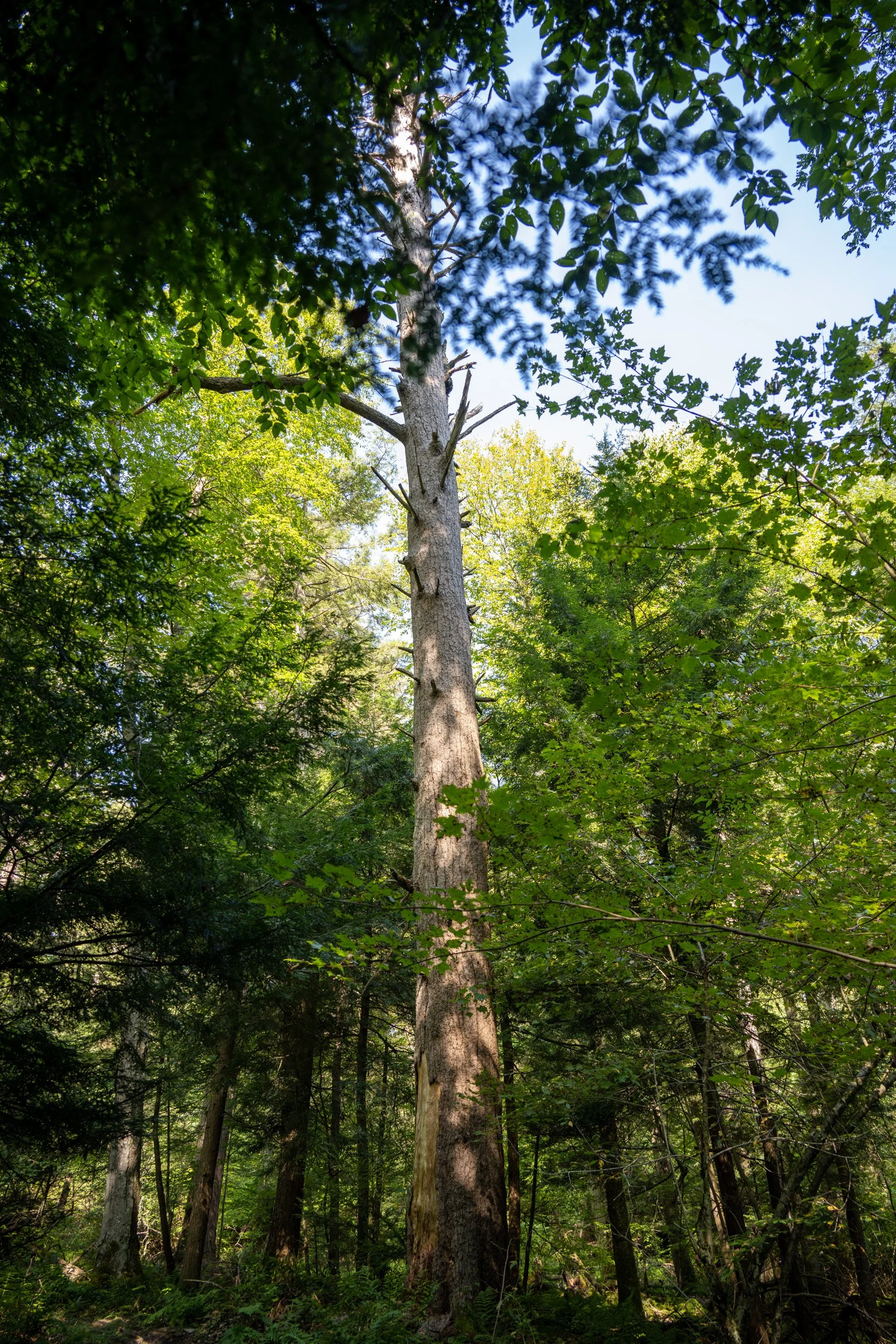


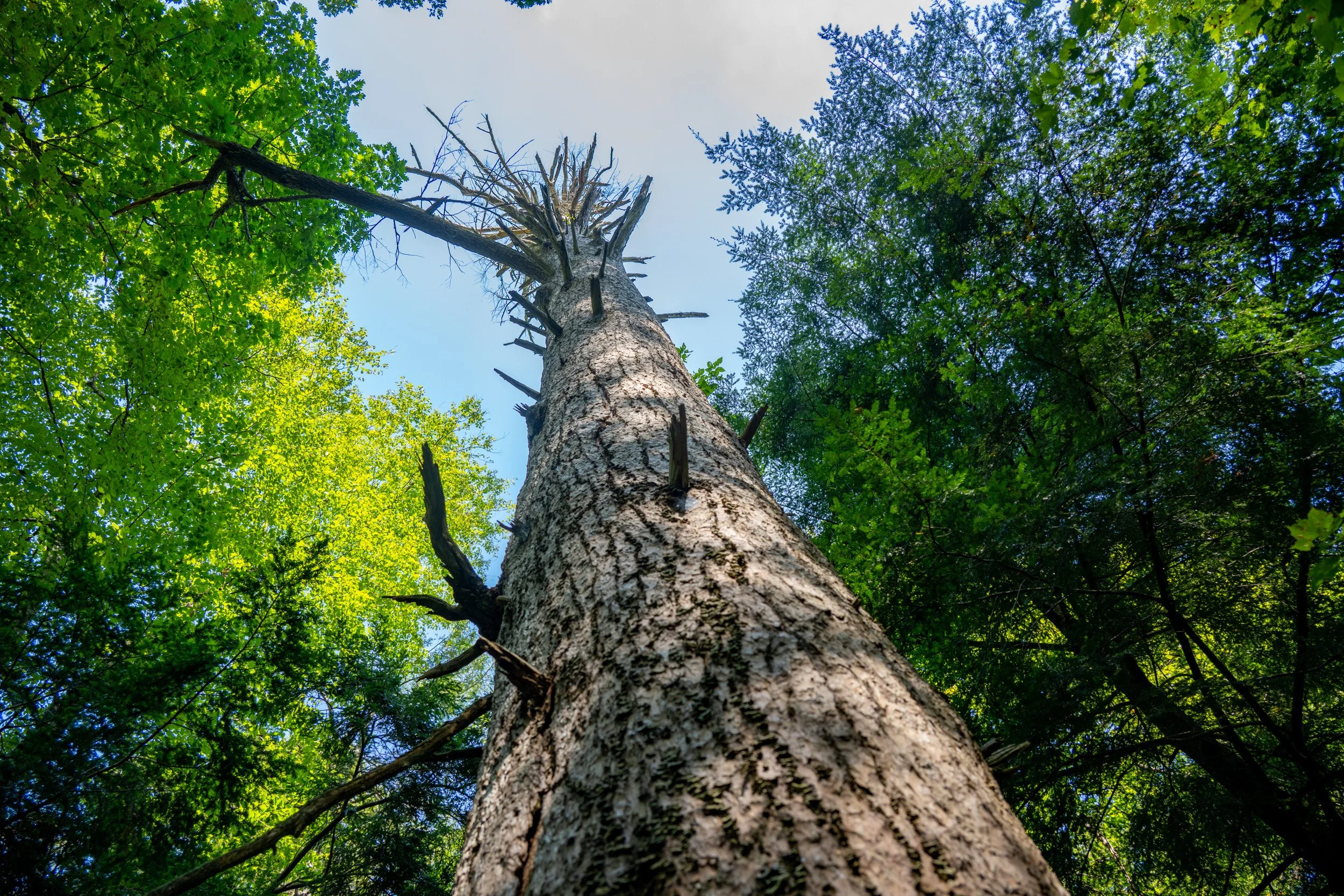


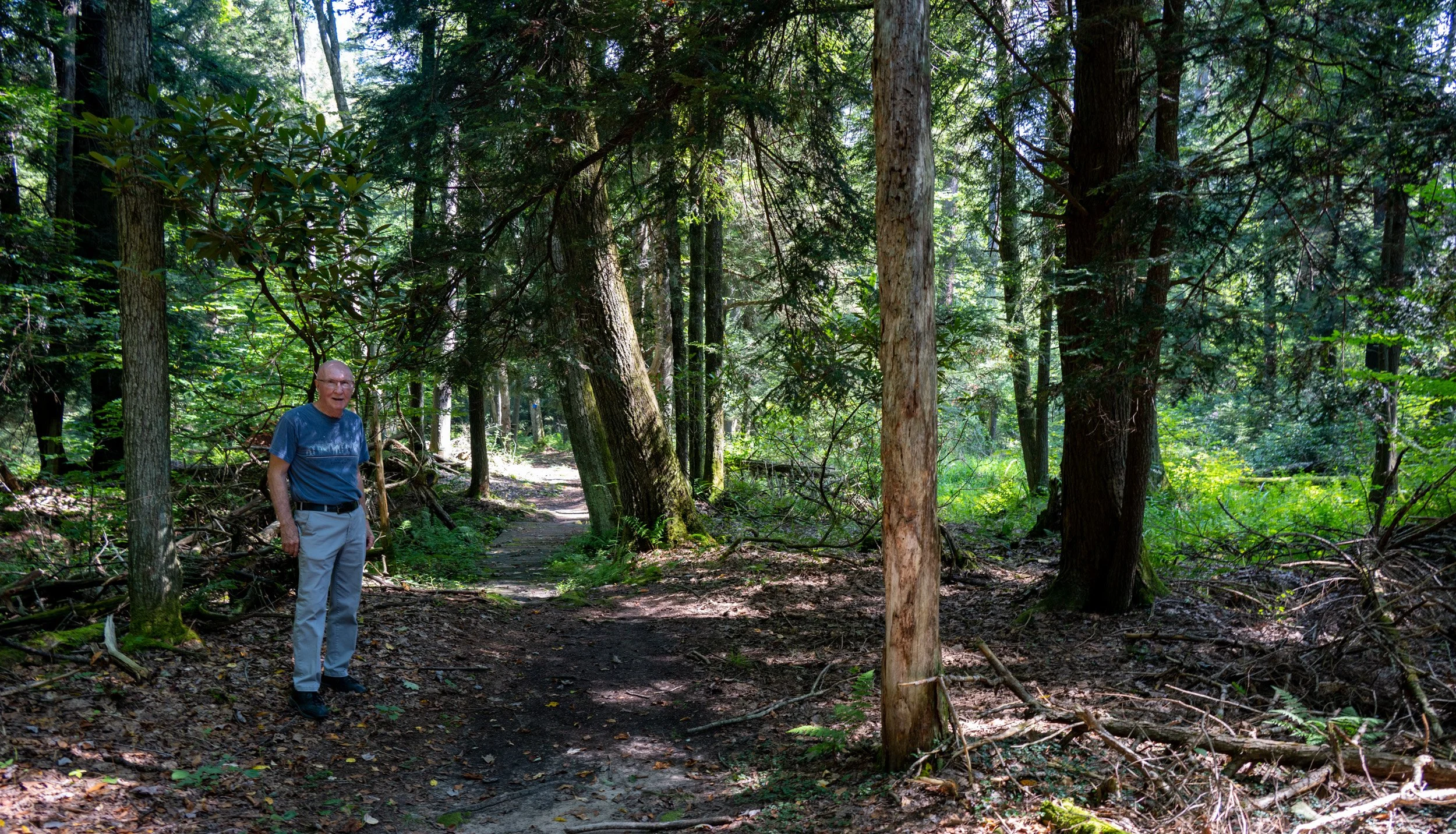


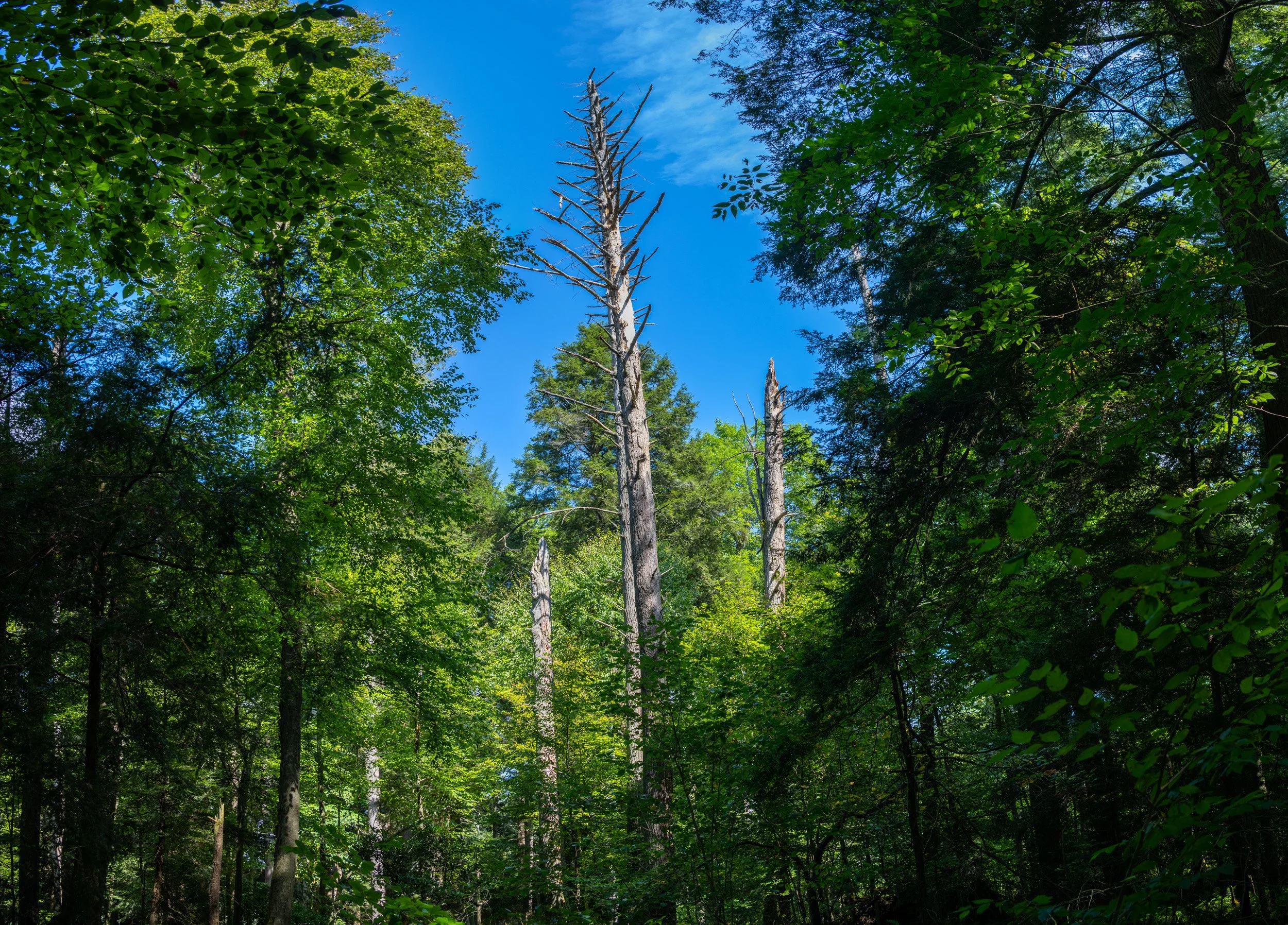


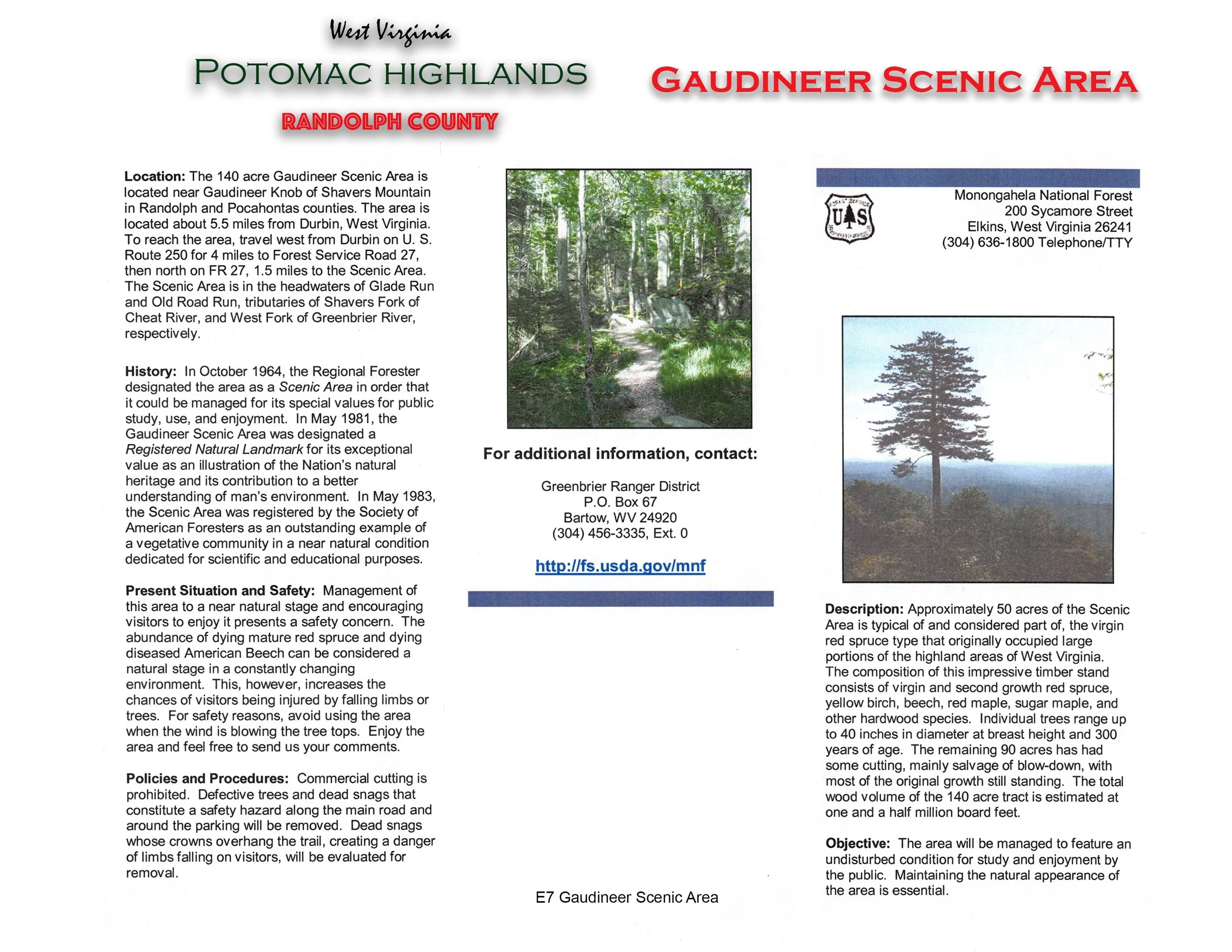
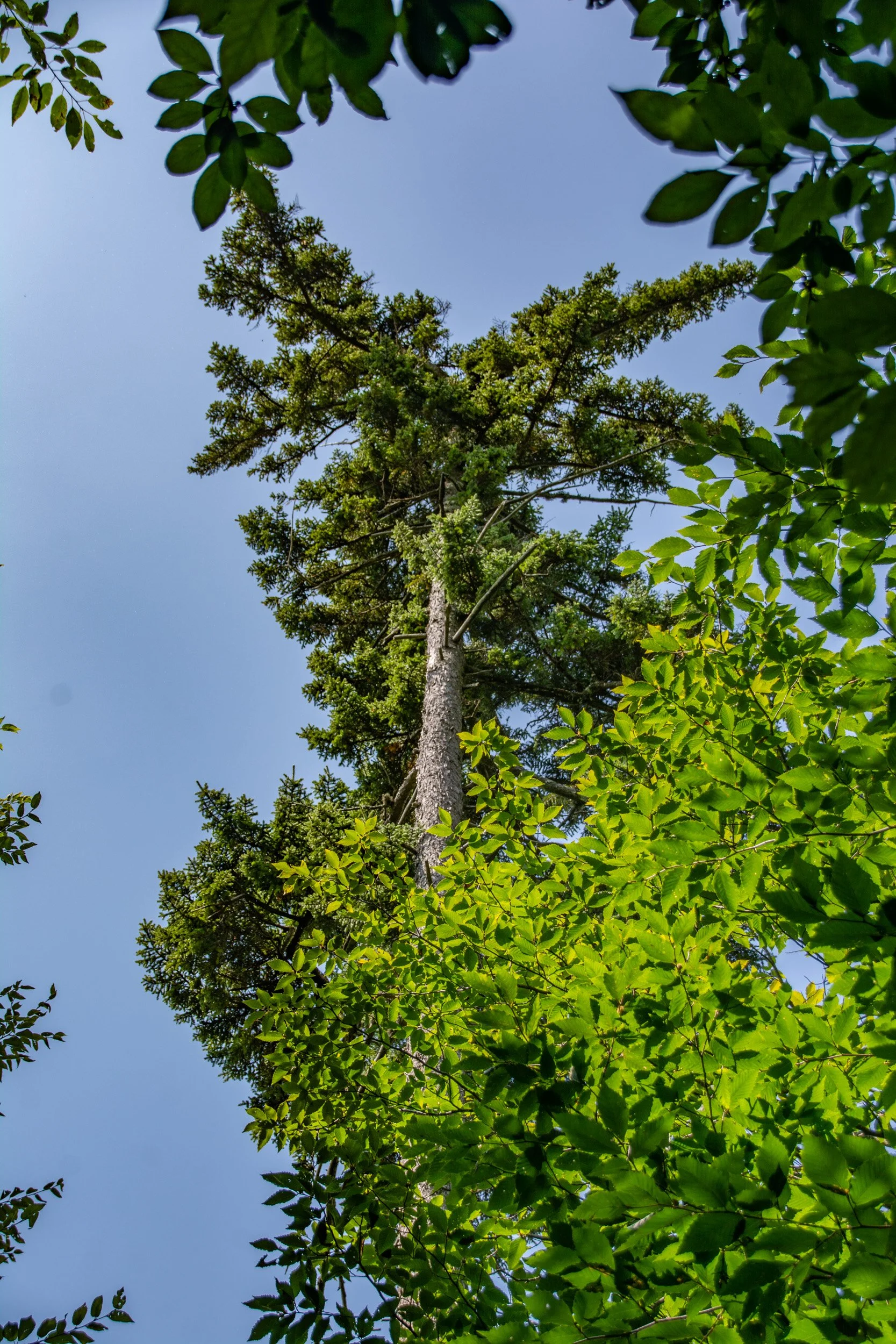
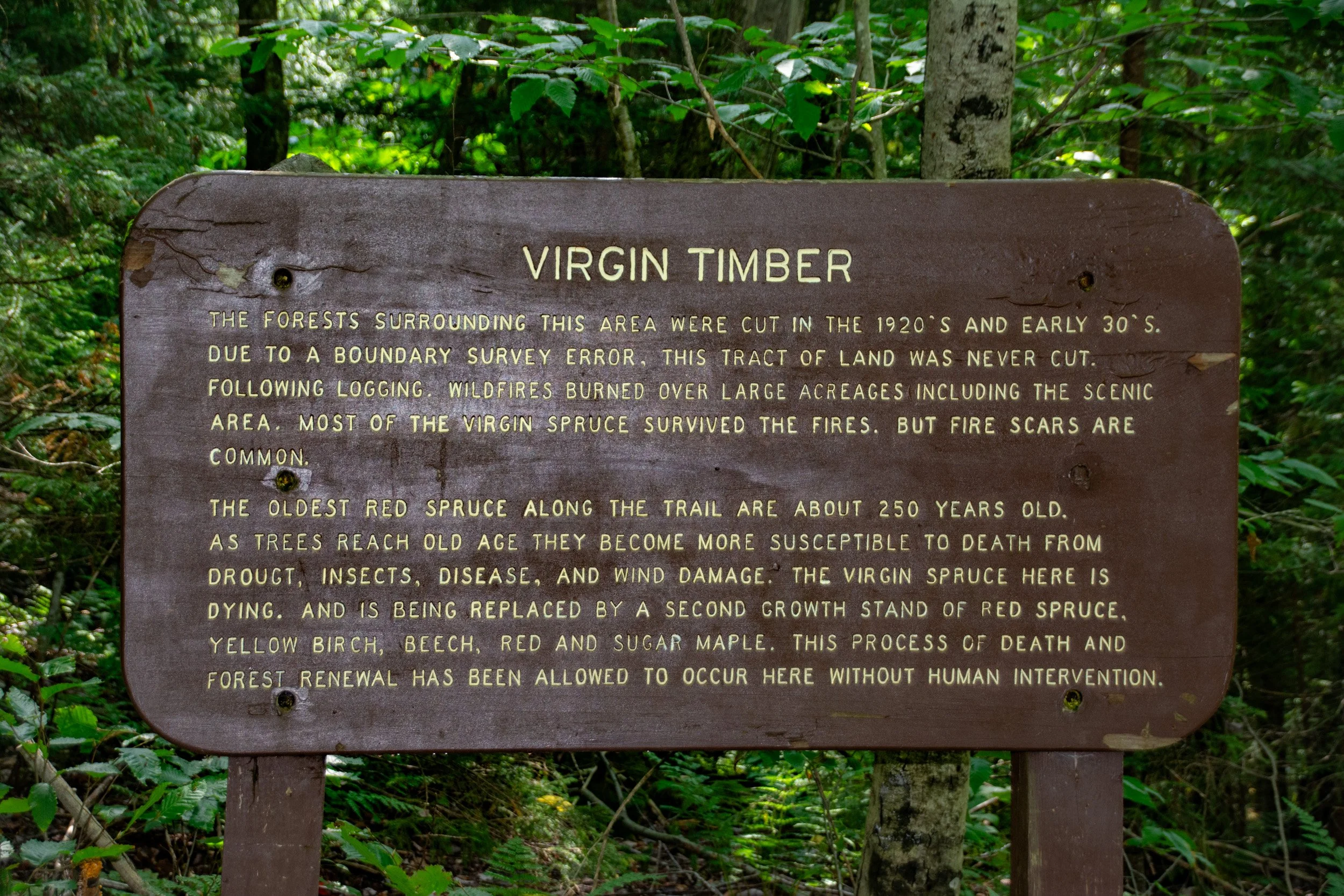
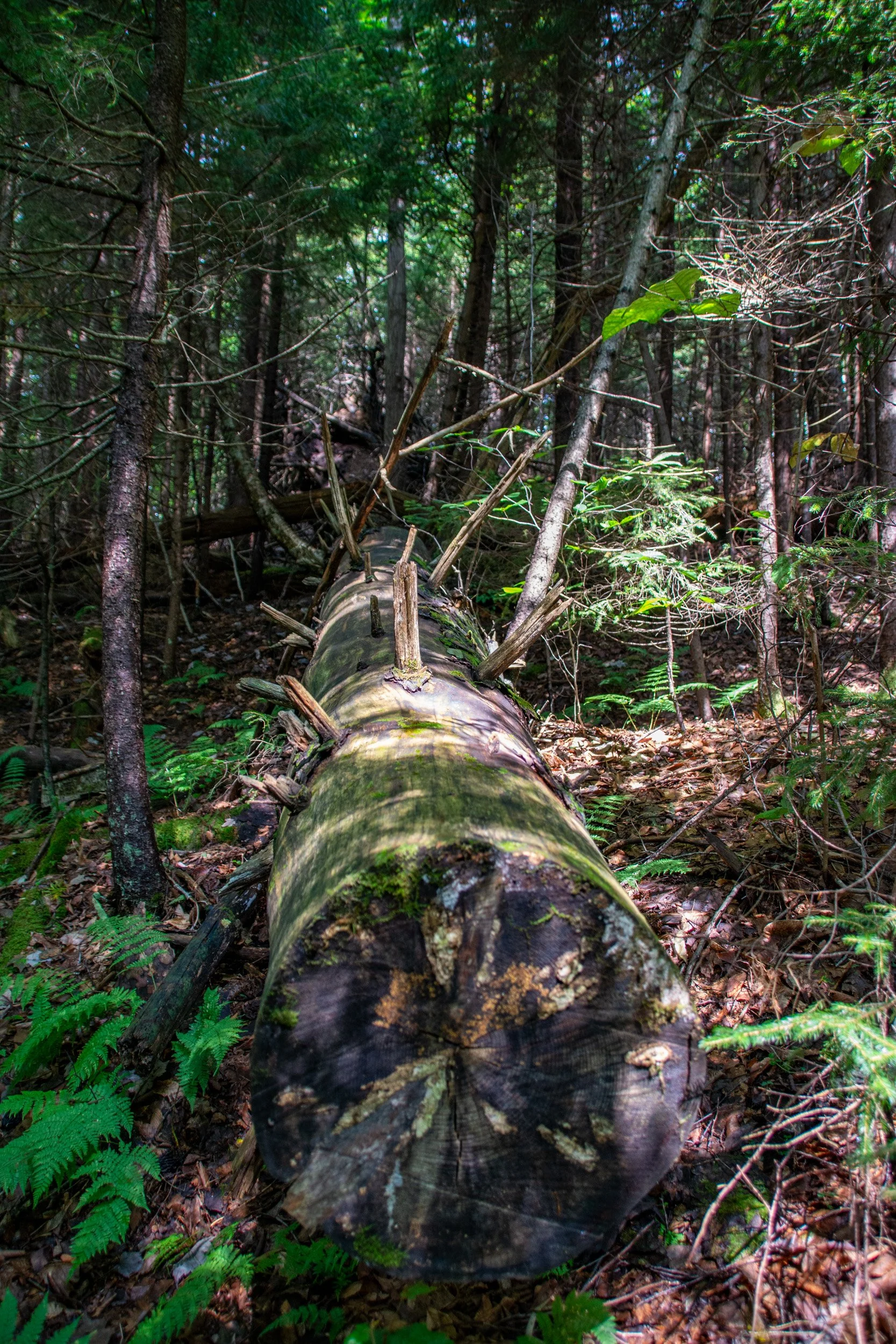

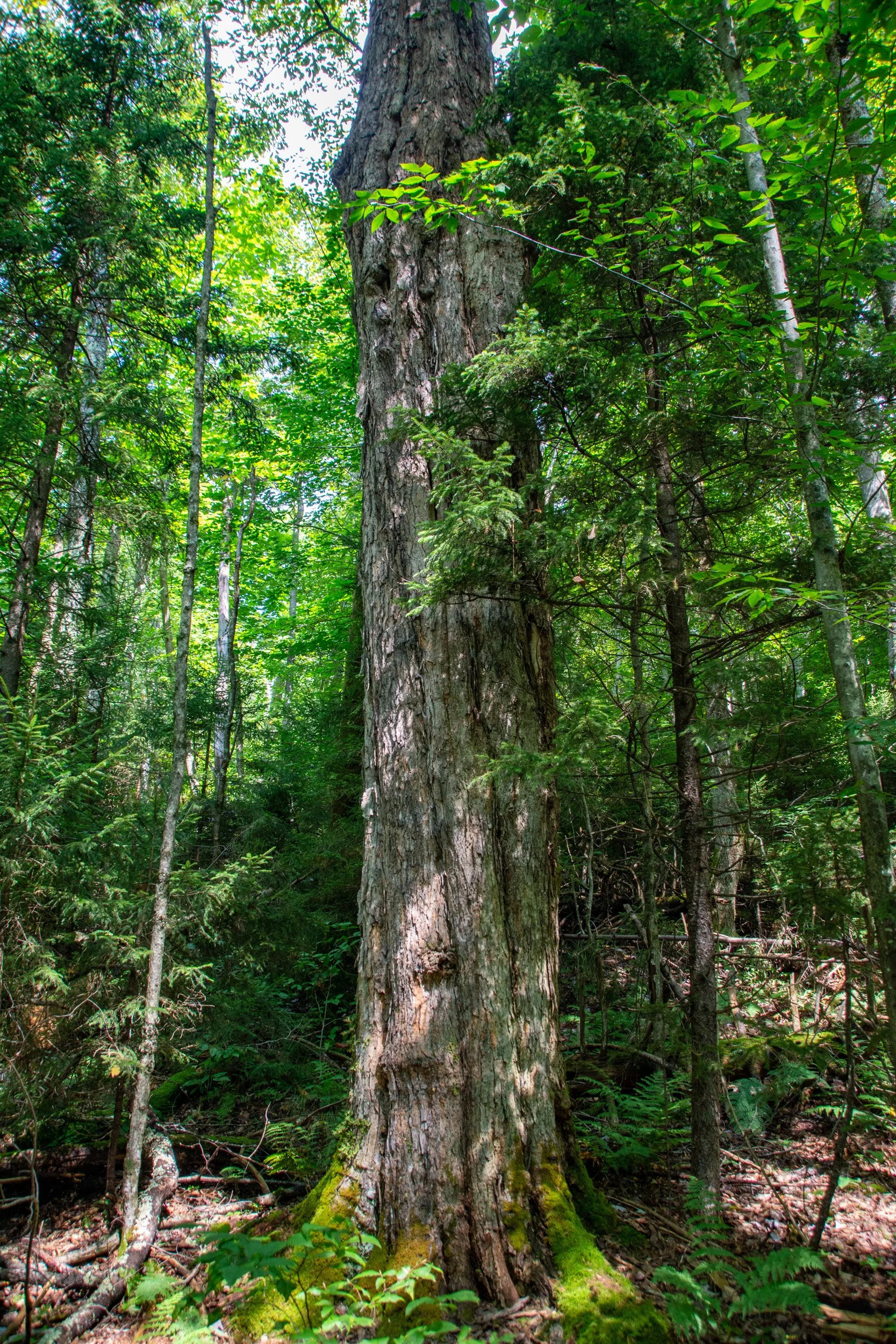


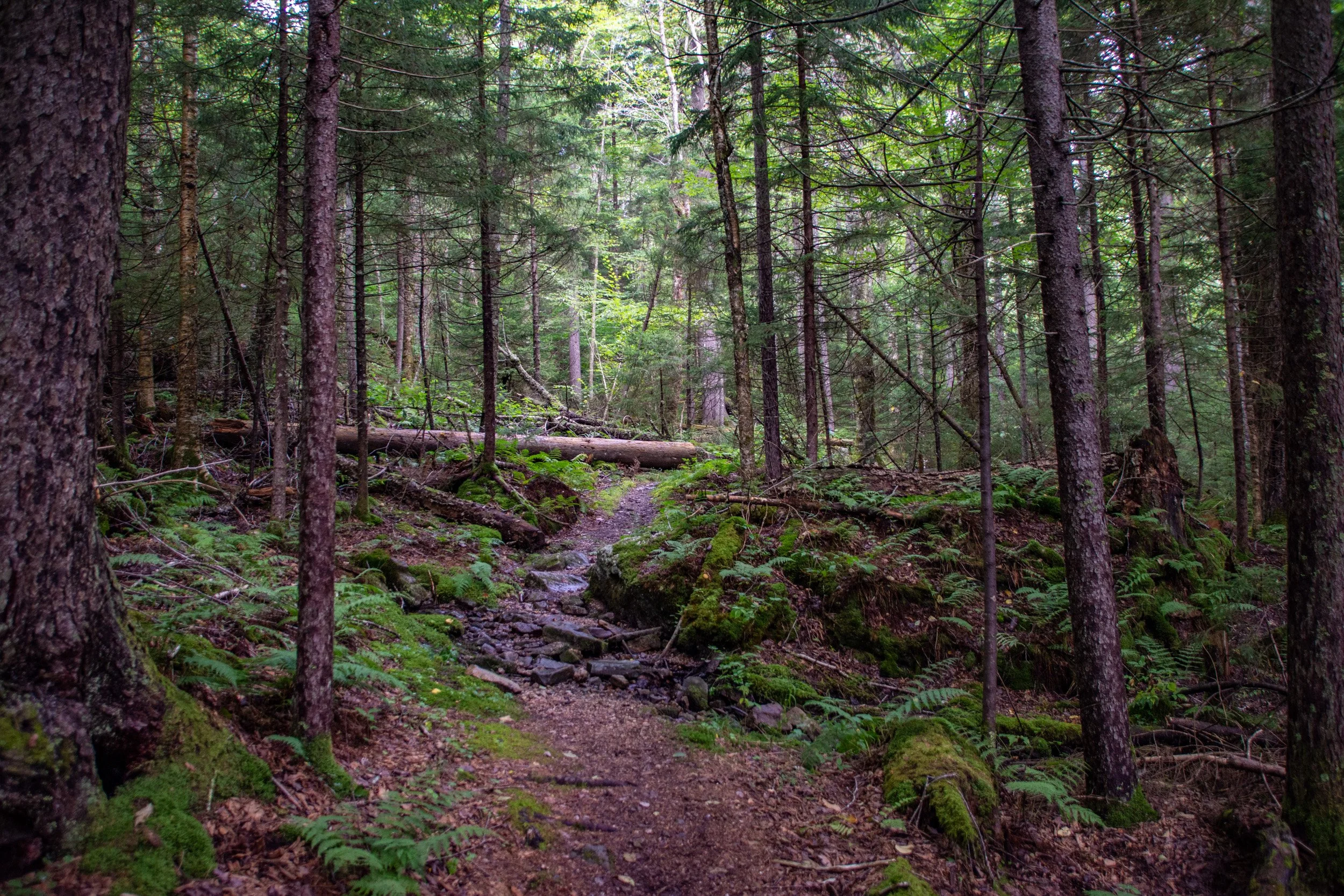
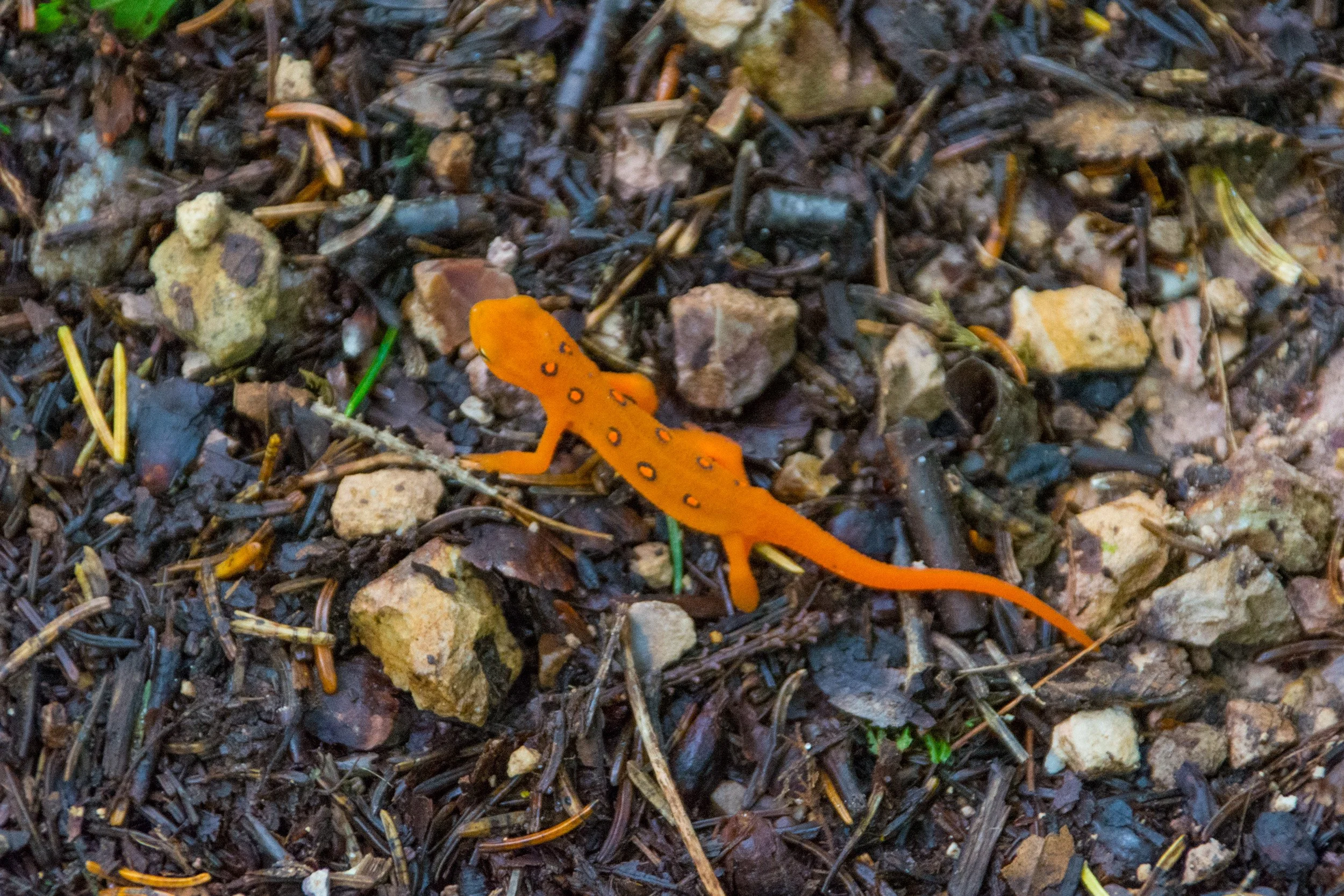

Coal was King!
Coal mining became the dominant industry by 1900—and remained so for decades. There were several locals who became millionaires via coal mining. Many entrepreneurs (local and far away) flocked to the Jefferson District for the oil and coal—the most famous of which was Michael Late Benedum a wealthy industrialist who was born in Fairmont, WV. See the story about him below and in the Post Office section.
Uncle Doyle recounts the story of local resident Terry Selinger’s rise to success.
-
See there in Bentree…well down behind that charcoal plant there was a great big gob pile out on that hill. But it was burning and stuff when we moved there. Where that gob had burned for years and years and years. There was a big mine there and there was mines just down around that curve from where you all lived. You can see the old…
Mike: Gauley Hollow, right?
Doyle: …but up this side [north side] of Gauley Hollow. You know where Elswicks had their mill. Well, just about across the road from that there use to be big cement piers. There was a tipple built.
Mike: I remember that.
Doyle: They mined that hill, well actually in that hill behind where you all lived, in there. Then they would mine that hill down there where you went up to Gauley Hollow. There was a lot of mining, in fact. Old man Walter Ramsey, he had a store there and Clem O’Dell had that other one up there. Then someone had a theatre there where they had showed silent movies. There was a pretty good size town in there at one time, in Bentree.
Mike: Do you remember that?
Doyle: No, it was all gone, even the tipple and stuff. I was talking to Lev Rogers, and he lived in that area. He was telling me about it. He said he used to come there to that store of Clem O’Dell’s when he was a boy. He told me who it was who got the contract to tear the tipples and stuff down. They were gone, but they could not have been gone very long before we moved there. They was in operation for quite a while, and they had the railroad come plumb up to where Elswick’s mill set. They run that train up there for years and years. They would come plumb up there and go back a hauling. They had their charter I reckon. Then they put that charcoal plant in--they done some business then. You probably remember Terry Selinger, he was one of the millionaires here in Nicholas County. He had little old mines up there right above Ida church on the left side, just about the time you’d go around that curve, on the left-hand side. He had mines on the side of that hill, him and George Hill. And they had a little old two and half ton Chevrolet truck they hauled the coal from that mine. They had a ramp built down there at the lower end of that charcoal plant. They would back it up and dump it into railroad cars. I think Terry Selinger, he’d drove truck part of the time, and George worked in the mine. But I guess both of them worked in the mine part of the time. They had ponies that pulled the coal out and that is where they were mining it back in that time. George Hill, he quit, and Terry Selinger was going up in here into Nicholas County. He was making money hand over fist. He was worth several million dollars, for a little while. But that was where he first started. I am sure Damon could tell you more about it than I could. When Mom and them had that store down there and that filling station, Selinger bought his gasoline off them on credit there. He would buy gas there, hauling coal and before long he was getting into money. He was one of the early ones. Well, there was a lot of people here in Nicholas County made millions of dollars, millions and millions of dollars in that coal business. You see there was a time, I guess after you was out of college, coal went to $100 a ton or something like that. It was said that people made money hand over fist at that time. A tremendous amount of money people made. Before that there had been some big mines. Now Bentree was, I was thinking it was called something else besides…Scotland?
Mike: It was called Scotford.
Doyle: You know where Etta Jane lives, they called that something along in there.
Mike: I believe it was called Cambria. [And Doyle agreed.]
Railroads Enabled it All:
The introduction of railroads in the 1820’s and 1830’s fundamentally changed America. With the invention of steam locomotives, it was possible for railroads to start connecting cities and towns across the nation. This rapidly created a continental transportation system, allowing goods to be transported around the country in an efficient manner. The railroads offered transportation that was much faster and cheaper than predecessors (wagons, waterways, navigable rivers, and intracoastal ocean traffic).
By the 1850s, most Americans had replaced horse-drawn carriages with trains as their primary mode of transportation.
Railroads changed the way Americans viewed their nation, giving them an optimistic view of the future. With the development of new steam locomotives, technological progress accelerated; railroads soon became the dominant form of transportation.
The growth of railroads also allowed settlements to develop deep into areas previously inaccessible by land such as along mountain ranges like those found in Appalachia, where coal could be transported more easily or timber harvested faster than ever before.
There were several Class I system railroads operating in West Virginia, but the C&O served the counties in which we are interested. By 1948, there were 3,696 miles of railway operating by common carrier railroads in West Virginia (not including logging and industrial lines).
Branch Lines to the Rescue:
The Chesapeake & Ohio operated in a generally west-west mainline direction through the southern part of West Virginia…following the Greenbrier, New, and Kanawha Rivers and passing through Charleston and Huntington. There were scores of branch lines for hauling coal from the New River, Kanawha, Coal River, Logan and Greenbrier coal fields.
The Logging Industry Had its own Railroads:
Logging had its own railroad activity. To tap the huge virgin forests, a way had to be forged to get the logs to the mills. The loggers used roughly built lines specially designed locomotives and cars to accomplish this. From the mills, the finished lumber was transported by the major railroads to markets all over the eastern United States. A great deal of the housing in the eastern US (in the 1890’s - 1920’s) was built with lumber from West Virginia forests. Coal was always the state’s main resource, followed by forest products.
Because of the rough terrain and widely dispersed population, railroads remained the best means of transportation for goods and people in WV longer than in many other areas of the country. The branch line passenger service held on here a little longer than in more developed and populated regions.
West Virginia Tourist Railroads:
Over the last 50 years, the state has developed a number of tourist railroad operations that capture the romance and history of this era. Three examples are given below. See WV Travel Information for more details.
Image 1: Cass Scenic Railroad
Image 2: Potomac Eagle Scenic Railroad
Image 3: Tygart Valley Flyer—Mountain Rail Adventures
What’s in a Name?
[First, it should be noted that no one seems to know where the name Scotford came from or when it was adopted. A lot of the WV settlers came from Scotland, so maybe that was the connection.]
———————————————-
• I have heard a couple different explanations regarding how and why the town’s name was changed from Scotford to Bentree.
Granny Kiser’s version is given below (audio and transcription):
-
Mike: When did they change the name from Scotford to Bentree?
Laura: Well. I cannot remember the year, Michael. But it was while I was living there. I was probably a teenager. I would maybe think when I was 8 or 10 years old. How come they changed the name: there was a gentleman came in from, where I don’t know, and opened up new mines, and that is where it got its name. I think his name was Benjamin and instead of calling it Benjamin, they called it Bentree. And that is how it came about that they changed the name from Scotford to Bentree.
Mike: Was his last name Tree or something?
Laura: Yeah! Benjamin Tree was his name. I thought that was rather clever.
• This is one explanation of the name change. My personal opinion is that this is less likely than another possible scenario related through Bea Morris’s write-up on the Bentree Post Office:
“Business partners, Michael Late Benedum and Joseph Trees came to Scotford to mine coal. [Or perhaps they initially had planned to drill for oil, but instead decided that coal was easier and more profitable.] Whether intentional or not, they sold dirty coal and hence earned a bad reputation. [The definition of ‘dirty coal’ has changed since 1900. At that time, it referred to lower grade coal or coal at the margins of the seam that had impurities in it.] A lot of customers veered away from coal that came from Scotford. So those two men got together and changed the name to Bentree (a combination of their last names). Then they were able sell coal that was not from Scotford; it was from Bentree.”
• There could be other explanations for the name change.
Mr. Benedum earned a stellar reputation for philanthropy and generosity, which seems at odds with the second story. Perhaps the name was changed just because the residents wanted to honor the two men for doing so much for the community.
We may never know the true story.
Brief Biographies of Benedum and Trees:
The lives of Michael L Benedum and Joseph C Trees were so intertwined that it is difficult to separate their accomplishments. They saw themselves as partners and fellow adventurers in the great game of oil discovery. Both men were products of the West Virginia oil boom of the 1890's.
Mr. Trees was an operating man, an engineer and an expert in drilling. Mr. Benedum had a flair for finances and for assessing risks. Their talents were different and their personalities were different, yet they worked smoothly together throughout their lifetimes.
Each was willing to let the other go it alone if he so chose. Their partnership lasted until Mr. Trees died in 1943. Mr. Benedum died in 1959 at the age of ninety. He had then become a legendary figure, mixing in the early days of the industry into the computer age of today.
The Post Office Legacy:
I have included information about the post office because three Rider’s (Issac, George Henry, and Posie) were post masters in the first half of the 1900’s. The entire list of Bentree Post Office postmasters is shown below:
• First Postmaster was William Tamplin (6/1/1904- 06/16/1910)
• Second Postmaster, Walter J. Ramsey (6/16/1910-2/25/1911)
• Third Postmaster, H.H. Sizemore (2/25/1911-10/2/1912
• Fourth Postmaster, Issac Lafayette Rider (10/2/1912-4/18/1919)
• Fifth Postmaster, Lawrence R. Grose (4/18/1919-7/28/1924)
• Sixth Postmaster, George Henry Rider (7/28/1924-12/4/1929)
• Seventh Postmaster, Posie Ann Rider (4/11/1930-6/1/1947)
• Eighth Postmaster, Violet McGraw (6/1/1947-4/14/1961)
• Nineth Postmaster, William McGraw (4/14/1961-11/9/1962)
• Tenth Postmaster, Elenora (Bea) Morris (11/9/1962-1990)
• Eleventh Postmaster, Karen Perkins (1990-19XX)
• Twelfth Postmaster, Mary Ann Clark (19XX-9/29/1995)
More information is available in the folder labeled Bentree Post Office.
Bentree Families Remembered:
In the process of sorting through old photos from various relatives, I came across many unidentified people who lived in Bentree (or were associated with Clay/Nicholas Counties). As one might expect, many of these people may have been cousins or related by marriage. I have tried to point out the connections when possible. If I don’t know who in a photo, I may still include it, with the hope that someone else may be able identify the person.

